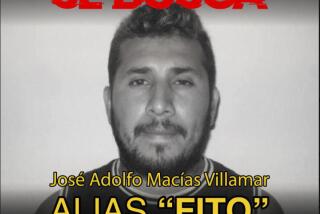Strengths of Ruthless Spy, Bookish Cop
- Share via
The former field marshal of Peru’s war against terrorism awaits trial today in the very prison he designed for his foes.
Accused of everything from commanding death squads to running guns to guerrillas, former spy chief Vladimiro Montesinos sits in the fortified naval prison where he once had Frank Sinatra tunes played for the conjugal visits of Abimael Guzman, guru of the Sendero Luminoso guerrillas, in a psychological campaign to win Guzman over.
In the midst of their disgrace, Montesinos and former President Alberto Fujimori no doubt cherish their victories over the guerrillas who came close to destroying Peru. The most spectacular triumph was a raid that ended a four-month hostage standoff in 1997, when commandos stormed the Japanese ambassador’s mansion in Lima, liberated 71 hostages and dealt a death blow to terrorism in Peru.
The raid gave Fujimori irrevocable tough-guy credentials; he never tired of talking about it. During an interview aboard the presidential jet in 1998, he reenacted the telephone call in which he gave the go-ahead to Montesinos, whose agents had infiltrated the mansion.
“I said to Dr. Montesinos: ‘Proceed!’ ” Fujimori recalled with a rush of euphoria. “At that moment I was living. I was living intensely!”
Swashbuckling stuff. Although Fujimori has taken refuge in Japan since his ouster in November, although he too is charged with a litany of crimes, the fear and violence of the past have all but evaporated from the streets of Lima, the mountains of Ayacucho, the Amazon jungles.
Fujimori and Montesinos fought terror with terror. They unleashed the military and intelligence service, created draconian special courts, locked terrorists in medieval prisons in the oxygen-deprived heights of the Andes.
But that is not the whole story. Peru also had the services of talented detectives with a far different philosophy, sleuths who were restrained, humane, intellectual--and who feuded with Montesinos.
The most intriguing questions about the Peruvian experience concern the relative merits of the two strategies. Who defeated terrorism: Montesinos, the ruthless spy, or Antonio Ketin Vidal, the bookish cop?
That oversimplifies matters, of course. There were plenty of anonymous heroes too, such as the peasant militias that fought the guerrillas. But in Peru, personalities make a difference. Montesinos and Ketin, former artillery school classmates, became indispensable to Fujimori after his election in 1990.
Their enemy was fearsome. Sendero Luminoso was as much a sect as an insurgency, and it seemed unstoppable. Its members were fanatical disciples of Guzman, called “Chairman Gonzalo,” a professor who cranked out Maoist tracts filled with hate. Sendero slaughtered mayors in remote village squares, blew up television stations in Lima, the capital, and turned entire prisons and shantytowns into fiefdoms.
And there was a second threat. The guerrillas of the Tupac Amaru Revolutionary Movement were less cruel and more conventional. They had a flair for well-organized ambushes, big-money kidnappings and daring jailbreaks. The startling takeover of the Japanese ambassador’s residence was a classic Tupac Amaru operation.
Their combined assault crippled Peru. During the 1980s and early 1990s, thousands became refugees, abandoning the highlands for Lima’s sprawling slums. Bombings caused constant power outages. Well-off Peruvians who couldn’t run to Miami retreated behind private sentries, barbed wire and walls topped with broken glass.
Fujimori made Montesinos his national security czar. Montesinos was good at what he did; his methods included brutality, bribery and a penchant for manipulative psychological operations.
Special terrorism courts were erected, and judges hidden behind masks, one-way mirrors and voice-distorting microphones handed down sentences that were swift and stiff. Plenty of terrorists were put away, but so were several thousand innocent Peruvians.
At the same time, Ketin commanded the anti-terror operations of the national police. His officers did their best to understand the enemy, actually taking the time to read Sendero’s literature. They treated prisoners with respect and poured their energy into surveillance and investigation. Their motto was “conquest without combat.”
In 1992, Ketin’s officers dealt a fatal blow to Sendero by tracking down Guzman in a hide-out above a Lima dance studio. Ketin refused to turn him over to Montesinos’ men, fearing that the prisoner would be executed.
Terrorism faded in the late 1990s, but Peru’s national security apparatus kept growing and the Fujimori-Montesinos regime ultimately self-destructed.
A transition government brought back Ketin last year and put him in charge of the manhunt for Montesinos, by then a fugitive and a threat to Peru’s stability. Ketin tracked him down in Venezuela last summer with the help of the FBI.
Montesinos surrendered to Ketin with the ironic tribute of a fellow warrior. “It was my turn to lose,” he said, the same words that Guzman had said when Ketin captured him nine years before.
The drama of Montesinos’ fall and Ketin’s rise may be the most important lesson of Peru’s battle with terrorism. Montesinos’ methods brought short-term results but eventual disaster. In order for Peru to return to democracy, the rule of law had to prevail.
That seems reassuring. But it’s hard to believe that, in the crucial years of the struggle, Peru could have won the war without both the cop and the spy.
More to Read
Sign up for Essential California
The most important California stories and recommendations in your inbox every morning.
You may occasionally receive promotional content from the Los Angeles Times.










